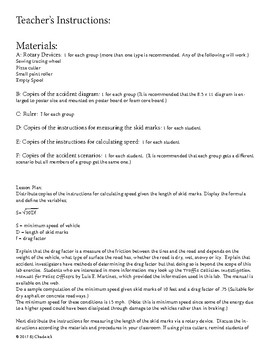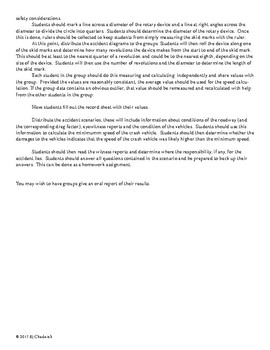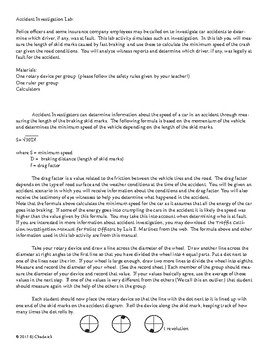Accident Investigation Lab for Trig Students
BJ Chadwick
2 Followers
Grade Levels
10th - 12th
Subjects
Resource Type
Standards
CCSSHSG-C.B.5
CCSSMP1
Formats Included
- PDF
Pages
12 pages
BJ Chadwick
2 Followers
Description
A lab exercise in which students complete a simulation of investigating a vehicle accident by measuring the length of skid marks and calculating the speed of the braking vehicle. Students will measure the length using the number of revolutions and diameter of a rolling rotary device (such as sewing tracing wheel or pizza cutter.) This lab is designed for groups of 2 - 4 students and contains 5 different scenarios of the accident so different groups can analyze different situations. These materials include directions for the instructor as well as instructions for the student, record sheets, and a diagram of the accident scene.
This lab works well as a joint classwork and homework activity where students measure and perform the calculations in class and analyze the scenario/situation for homework. Students write a brief report of their investigation and could be required to make an oral report as well.
The information for the calculations comes from a manual for police officers which is available on the web for students or instructors who wish more information on accident investigation techniques.
This lab works well as a joint classwork and homework activity where students measure and perform the calculations in class and analyze the scenario/situation for homework. Students write a brief report of their investigation and could be required to make an oral report as well.
The information for the calculations comes from a manual for police officers which is available on the web for students or instructors who wish more information on accident investigation techniques.
Total Pages
12 pages
Answer Key
N/A
Teaching Duration
40 minutes
Report this resource to TPT
Reported resources will be reviewed by our team. Report this resource to let us know if this resource violates TPT’s content guidelines.
Standards
to see state-specific standards (only available in the US).
CCSSHSG-C.B.5
Derive using similarity the fact that the length of the arc intercepted by an angle is proportional to the radius, and define the radian measure of the angle as the constant of proportionality; derive the formula for the area of a sector.
CCSSMP1
Make sense of problems and persevere in solving them. Mathematically proficient students start by explaining to themselves the meaning of a problem and looking for entry points to its solution. They analyze givens, constraints, relationships, and goals. They make conjectures about the form and meaning of the solution and plan a solution pathway rather than simply jumping into a solution attempt. They consider analogous problems, and try special cases and simpler forms of the original problem in order to gain insight into its solution. They monitor and evaluate their progress and change course if necessary. Older students might, depending on the context of the problem, transform algebraic expressions or change the viewing window on their graphing calculator to get the information they need. Mathematically proficient students can explain correspondences between equations, verbal descriptions, tables, and graphs or draw diagrams of important features and relationships, graph data, and search for regularity or trends. Younger students might rely on using concrete objects or pictures to help conceptualize and solve a problem. Mathematically proficient students check their answers to problems using a different method, and they continually ask themselves, "Does this make sense?" They can understand the approaches of others to solving complex problems and identify correspondences between different approaches.





